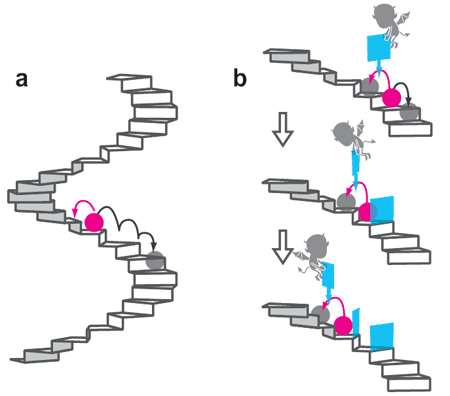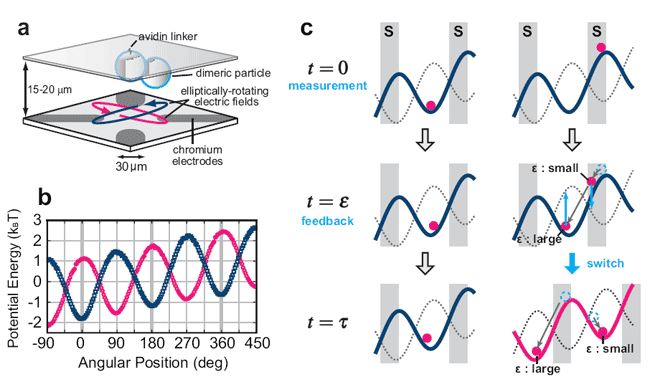Successful experiment to turn information into energy
On September 27, 2010, a group of Japanese scientists under the leadership of Soichi Tojabe (Shoichi Toyabe) published the results of an interesting experiment that serves as proof of the practical possibility of turning information into energy on the principle of a hypothetical Silard machine . Under the influence of constant feedback control (changing two electromagnetic fields), scientists managed to force a polystyrene particle to rise along a spiral staircase, receiving energy from the Brownian motion of molecules in the surrounding air.

The illustration from the scientific work depicts the demon Maxwell , who allegedly helps in the experiment.
The scientific work “Information heat engine: by feedback control” is in the public domain , you can familiarize yourself with the experiment.
Actually, the essence of the experience is shown in the diagram. Two electromagnetic fields with a frequency of 1 MHz. The movement of the particle was tracked by a video camera on a microscope (every 1.1 ms, exposure 0.3 ms), and each time a new step of the ladder jumped, the direction of the electric fields changed so that the particle did not roll back. Then the Brownian movement threw her onto the next rung of the ladder - and so on.
')

As a result, the "hot" molecules gather in one part of the ladder, and the "cold" remain at the bottom, although the initially equilibrium thermodynamic system did not receive any energy from the outside. It is not heated and not highlighted. The system received from the outside only information about the direction of the electromagnetic fields (roughly speaking, 0 or 1).
It turns out that the Japanese made the first engine capable of converting information into energy. According to experts , this invention will make a real revolution in the power supply of nanomachines.
Brief historical background. In 1929, American nuclear physicist Leo Szilard described a theoretical construction ( Silard's machine ) in which a hypothetical rational creature of microscopic size ( Maxwell's demon ) pumps energy from an isothermal medium and turns it into work.
After a fierce debate that lasted 80 years, physicists came to the conclusion that Maxwell's demons still did not violate the second law of thermodynamics. Thus, the Silard machine in principle can be created in reality. However, the experiments conducted so far have not given a clear confirmation of this hypothesis.

The illustration from the scientific work depicts the demon Maxwell , who allegedly helps in the experiment.
The scientific work “Information heat engine: by feedback control” is in the public domain , you can familiarize yourself with the experiment.
Actually, the essence of the experience is shown in the diagram. Two electromagnetic fields with a frequency of 1 MHz. The movement of the particle was tracked by a video camera on a microscope (every 1.1 ms, exposure 0.3 ms), and each time a new step of the ladder jumped, the direction of the electric fields changed so that the particle did not roll back. Then the Brownian movement threw her onto the next rung of the ladder - and so on.
')

As a result, the "hot" molecules gather in one part of the ladder, and the "cold" remain at the bottom, although the initially equilibrium thermodynamic system did not receive any energy from the outside. It is not heated and not highlighted. The system received from the outside only information about the direction of the electromagnetic fields (roughly speaking, 0 or 1).
It turns out that the Japanese made the first engine capable of converting information into energy. According to experts , this invention will make a real revolution in the power supply of nanomachines.
Brief historical background. In 1929, American nuclear physicist Leo Szilard described a theoretical construction ( Silard's machine ) in which a hypothetical rational creature of microscopic size ( Maxwell's demon ) pumps energy from an isothermal medium and turns it into work.
After a fierce debate that lasted 80 years, physicists came to the conclusion that Maxwell's demons still did not violate the second law of thermodynamics. Thus, the Silard machine in principle can be created in reality. However, the experiments conducted so far have not given a clear confirmation of this hypothesis.
Source: https://habr.com/ru/post/105296/
All Articles